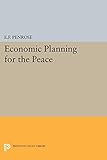Economic Planning for the Peace / Ernest Francis Penrose.
Material type: TextSeries: Princeton Legacy Library ; 1921Publisher: Princeton, NJ : Princeton University Press, [2015]Copyright date: ©1953Description: 1 online resource (400 p.)Content type:
TextSeries: Princeton Legacy Library ; 1921Publisher: Princeton, NJ : Princeton University Press, [2015]Copyright date: ©1953Description: 1 online resource (400 p.)Content type: - 9780691627205
- 9781400879700
- 338.91
- HC59
- online - DeGruyter
- Issued also in print.
| Item type | Current library | Call number | URL | Status | Notes | Barcode | |
|---|---|---|---|---|---|---|---|
 eBook
eBook
|
Biblioteca "Angelicum" Pont. Univ. S.Tommaso d'Aquino Nuvola online | online - DeGruyter (Browse shelf(Opens below)) | Online access | Not for loan (Accesso limitato) | Accesso per gli utenti autorizzati / Access for authorized users | (dgr)9781400879700 |
Frontmatter -- Preface -- Contents -- Introduction -- Chapter I. Negotiating a Text for Postwar Sermons -- Chapter II. A Period of Frustration -- Chapter III. Progress in Financial Planning for the Long Run -- Chapter IV. International Control of Raw Materials -- Chapter V. Planning to Reduce Trade Barriers -- Chapter VI. Drafting Proposals on International Trade -- Chapter VII. A Model Approach to Planning -- Chapter VIII. Food Relief Planning -- Chapter IX. Planning for International Relief -- Chapter X. The Problems of Transition and Reconstruction -- Chapter XI. An Attempt at Stocktaking -- Chapter XII. The Interregnum -- Chapter XIII. Germany: Reconstruction or Revenge? -- Chapter XIV. Disaster to Economic Planning on Germany -- Chapter XV. JCS 1067 and All That -- Chapter XVI. Reparation or "Deindustrialization" ? -- Chapter XVII. The Struggle to Change a Policy -- Chapter XVIII. Filling One Gap and Creating Another -- Chapter XIX. The Gathering Crisis -- Chapter XX. The Summing Up -- Index
restricted access online access with authorization star
http://purl.org/coar/access_right/c_16ec
If the end of war is not victory but peace, wartime plans for postwar peace assume importance beyond the war itself. This book shows how deeply the peace plans of World War II, beginning as early as 1941, were affected by political conditions, by wartime developments, and by personalities such as Roosevelt, Morgenthau, Keynes, Churchill, and Winant. It reveals how great successes were attained, saving Europe from immediate postwar disaster, while there were grievous errors which led to the crisis of 1947.Originally published in 1953.The Princeton Legacy Library uses the latest print-on-demand technology to again make available previously out-of-print books from the distinguished backlist of Princeton University Press. These editions preserve the original texts of these important books while presenting them in durable paperback and hardcover editions. The goal of the Princeton Legacy Library is to vastly increase access to the rich scholarly heritage found in the thousands of books published by Princeton University Press since its founding in 1905.
Issued also in print.
Mode of access: Internet via World Wide Web.
In English.
Description based on online resource; title from PDF title page (publisher's Web site, viewed 30. Aug 2021)


